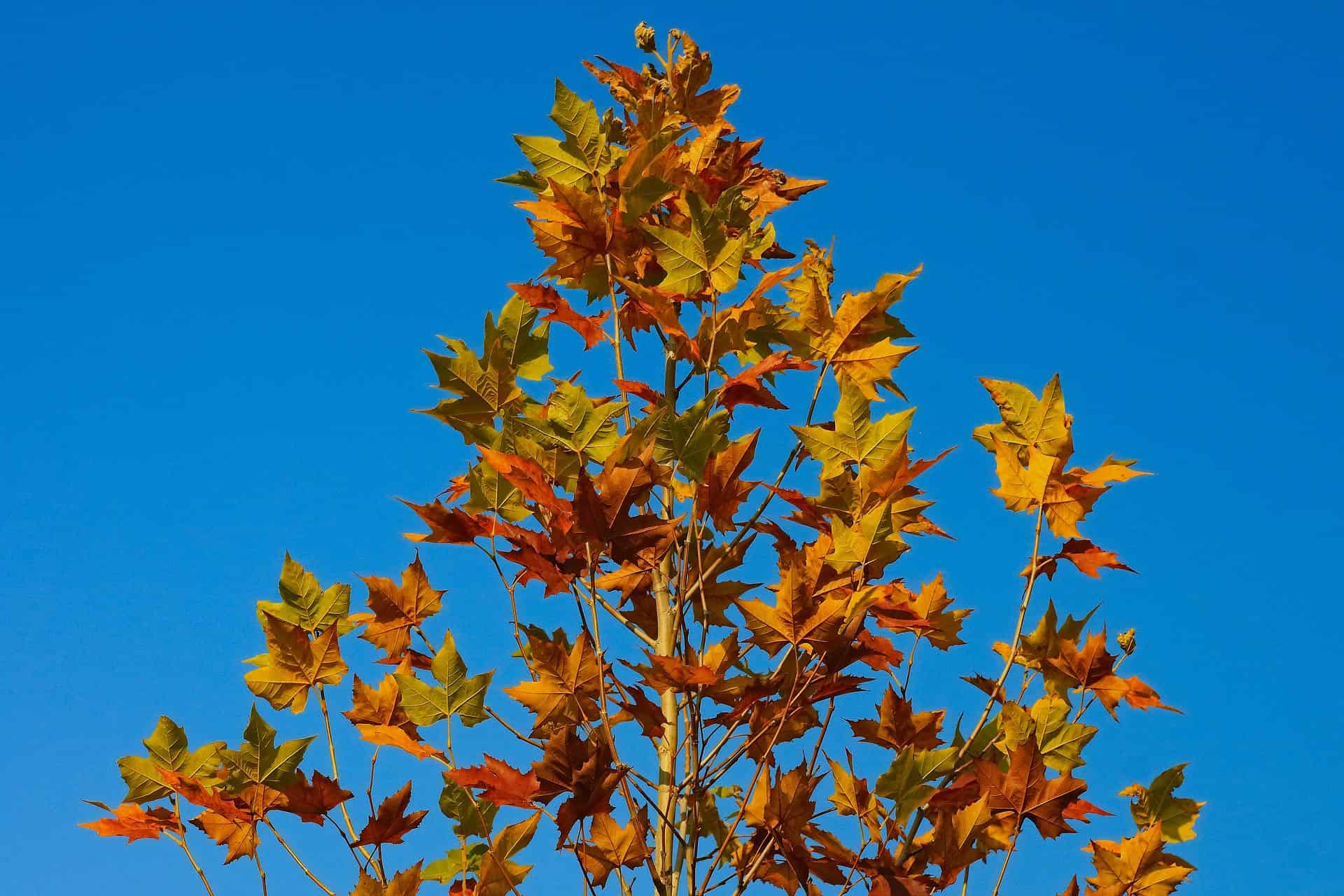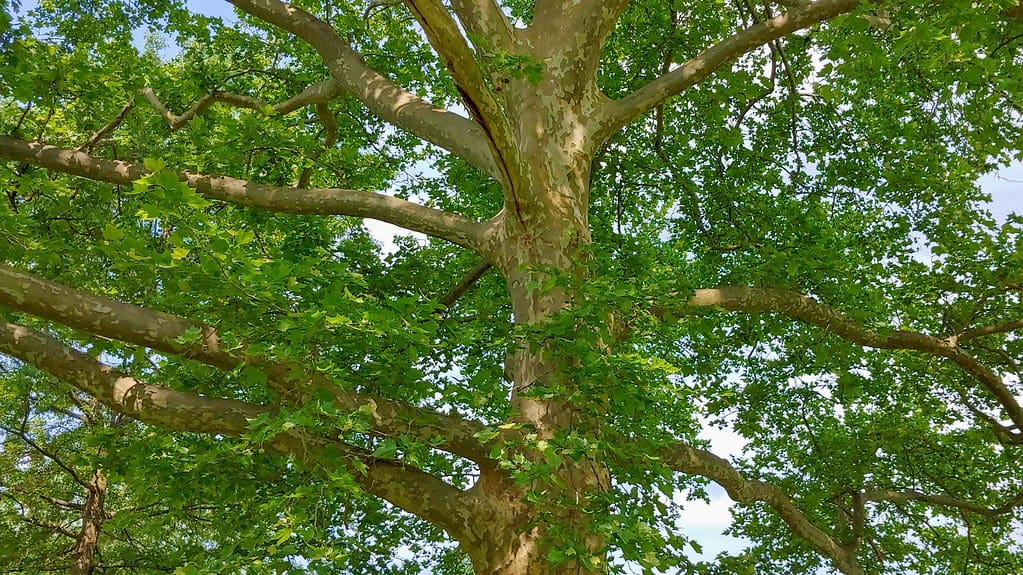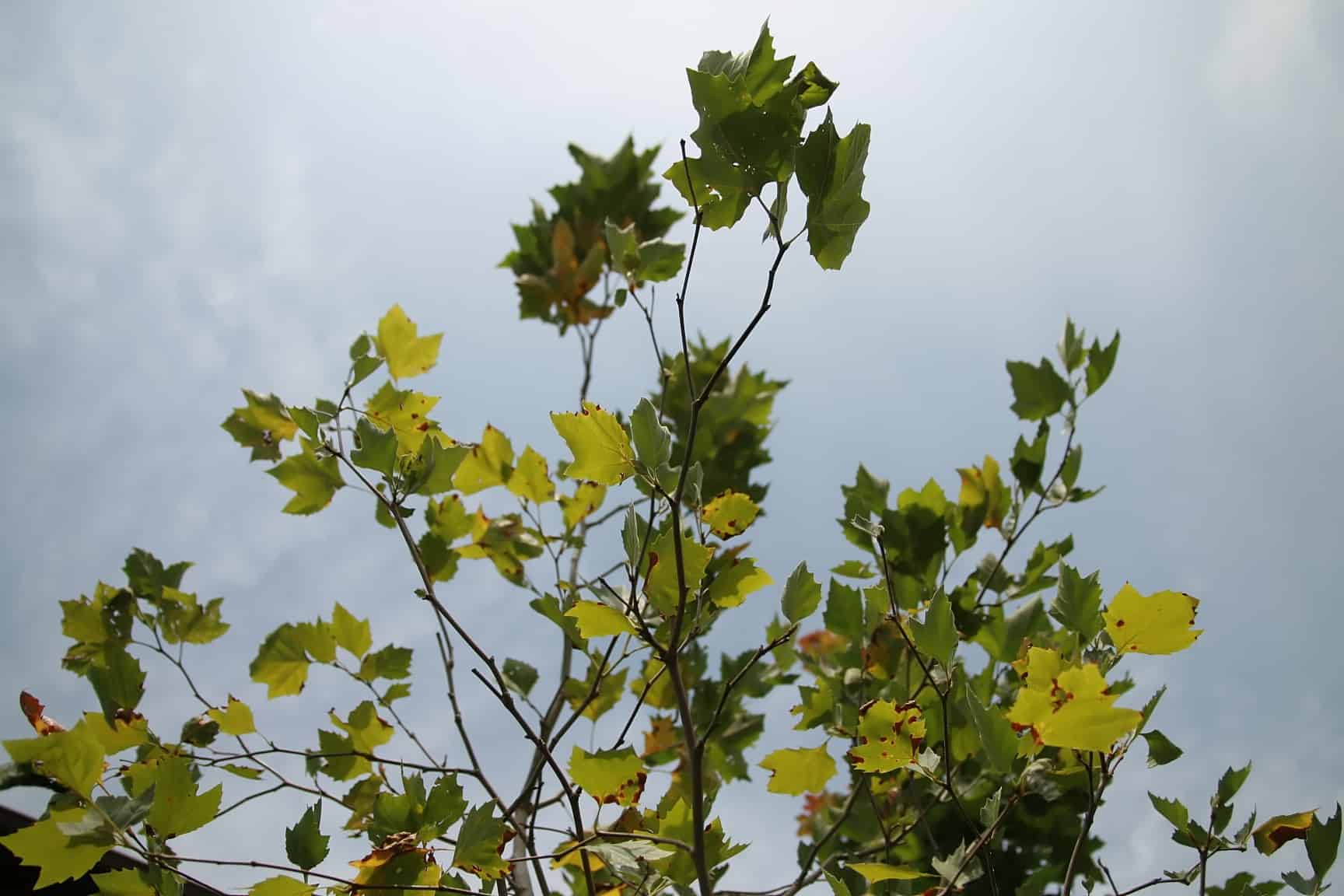No products in the cart.
Table of Contents
The London Plane is a huge deciduous tree that grows resilient in urban settings. The hybrid crossed two species, the Platanus accidentalis (American sycamore) and Platanus orientalis (Oriental planetree), thus creating the Platanus x acerifolia. It is a fast-growing tree, and it also transplants well.
Another spectacular highlight is the bark that peels away to show a cream-colored to the whitish-green inner bark. The green leaves spread up to 9 inches wide with three to five lobes, and the fall foliage is yellow-brown. The flowers appear small in early spring and ripen into fruits that turn brown in fall.
So, if you have not yet invested in this large tree, read the full care guide to the end.
London Plant Tree Care

The London Plane Tree grows well in urban conditions where you want a large tree to provide shade. It also makes for an attractive accent and tolerates air pollution well. You can also plant indoors in medians and strips as the root system handles small spaces with compact soil.
The tree can also live up to 400 years. Still, when you need to plant it, place it away from buildings and other structures. Another interesting fact is that it is a messy tree that sheds leaves.
Best Soil For Young Trees To Retain Soil Moisture
The first and most important thing is to provide your Platanus × acerifolia with well-drained soil. You can grow it in sandy, clay, or loamy soil with a pH level between 6.1 to 7.8. When grown in too much alkaline soil, the leaves turn yellow, and the roots start having problems developing downwards.
Lighting Needs For the Bright Green Leaves

When planting the London Planetree, it grows better in the full sun than in partial shade. The plants need at least six hours of sun from spring to fall. The tree does not grow well in urban conditions in part shade as it grows sparsely with a dwarflike trunk.
Watering Your Trees
The wagering requirement for these trees is moderate to high and depends on how warm it is. Hence, it prefers moist soil but is, to some extent, drought-tolerant. The best is to mulch around the base of your tree to help retain moisture.
With extended periods of no rain, we recommend giving your trees a good soak with the hose at the bottom of the tree. Young trees will need regular watering until established.
Temperature & Humidity For The Deciduous Trees

The London Planetree grows in a moderate climate and can tolerate hot summers and direct sun, but the soil needs to remain moist. It can also withstand a cold winter, but the foliage can sustain frost injuries.
Still, it remains a messy tree with fallen leaves, fruit balls, branches, and more during strong winds.
Fertilizing Your Trees
As you sometimes plant the plane tree in poor soil with limited spaces, it can lack nutrients. If it is the case with your tree, we recommend a good feed in early spring and fall. You can use a tree nitrogen fertilizer.
Still, we recommend taking soil samples to know what nutrients your tree needs.
Pruning London Plane Tree
When you do not prune your plane tree, it grows huge. Still, it helps trim the dying, dead, and diseased branches in winter. Another excellent technique to train your tree is pollarding to keep it short with club-like branches.
Pollarding means cutting your tree back to the trunk to produce dense branches. It also helps to do annual pruning to give it a unique shape. Another pruning style is preaching by braiding several branches together, forming a living fence.
But you need to start the process with young trees.
Propagation of London Plane Tree
You can use a cutting from a branch of your London Plane tree to propagate, but it is not 100% successful. Another method is grafting to help preserve your London Plane tree traits. The best time to propagate is in early spring when you see new eyes or buds growing on branches.
Here are some steps you can follow:
Take your garden loppers to cut a healthy branch about ten inches long. Choose one with two to three buds or growth nodes and cut it with a growth node at the cut end.
Use some rooting hormone powder, dip the cut end into it, and place it into a large container with some potting soil. Or you can put it directly into the ground.
Water frequently to ensure the soil remains moist but not soggy.
You will see the cutting sprout new leaves, but they will fall off. Please do not give up, as it will sprout new leaves again. Once this happens, you know it has developed roots.
Growing London Plane Tree From Seed
While this takes a long time, it is a great way to grow your tree if you are not in a hurry. You can gather seeds from your tree that looks like fluffy balls. Let the seed soak in water for 48 hours and spread the seed across starting soil in a tray.
Keep the soil moist by misting them and leaving the tray in bright indirect sunlight.
It should take about two weeks for the seed to germinate. When the seedlings are about two inches tall with new roots, you can place them in separate containers with potting soil. Please leave them in the direct sun for four hours daily and water them to moisten the soil.
London Plane Tree Varieties
According to botanists, the hibernation of the tree happened during the 17th century in London or Spain. It happened when the American sycamore and Oriental planetree were standing close together. There are several cultivars found these days that include the following:
Bloodgood
It is a popular variety that grows up to 60 feet tall and can thrive in poor soil to drought.
Columbia
The tree has dark green leaves growing up to 50 feet tall and can resist powdery mildew, anthracnose, and heavy pruning.
Liberty
It is a quick-growing tree with a pyramidal shape reaching up to 50 feet. It also has a high tolerance against powdery mildew, drought, and pruning.
Metzam or Metroshade
The tree grows up to 70 feet tall with reddish cast leaves that turn a bright green.
London Plane Tree Common Pests and Diseases
The London Planetree gets affected by the same fungus as the American sycamore known as anthracnose. Other concerns are powdery mildew, leaf spots, and cankers. When a tree is mature and diseases are present, it results in leaf loss but does not cause serious harm.
You can remove the infected branches and dispose of the fallen leaves and twigs. Common pests are the sycamore lace bug, borers, Japanese beetles, mites, and caterpillars. You can treat your small trees with an insecticide spray but not practical to use on a large tree.
Common problems with the London Plane Tree are the roots that cause severe damage lifting to cracking structures.
Frequently Asked Questions
The tree can live for several years, and the oldest one is found at the Archbishop of Canterbury and is believed to date back to 1685.
The London Plane Tree can grow up to 24 inches yearly in full sun.
The root ball to the stem and branches is hardy as it can grow in the hardiness zones 5 to 9 in moderate climate regions. In addition, the tree has a drought tolerance to grow in full sun to partial shade.
The tree’s root system can grow deep, but when it does not receive nutrients and water, it can also grow shallow and cause a lot of devastation to a foundation.
The London Planetree is messy as it sheds its leaves and fruit throughout the year.
The London Planetree you can find at your local garden center or nursery. Still, you need not look far as Plantly also has it available for you to buy.
Whether you want to buy, sell or simply reach out to other plant enthusiasts, Plantly is the right place to be!


